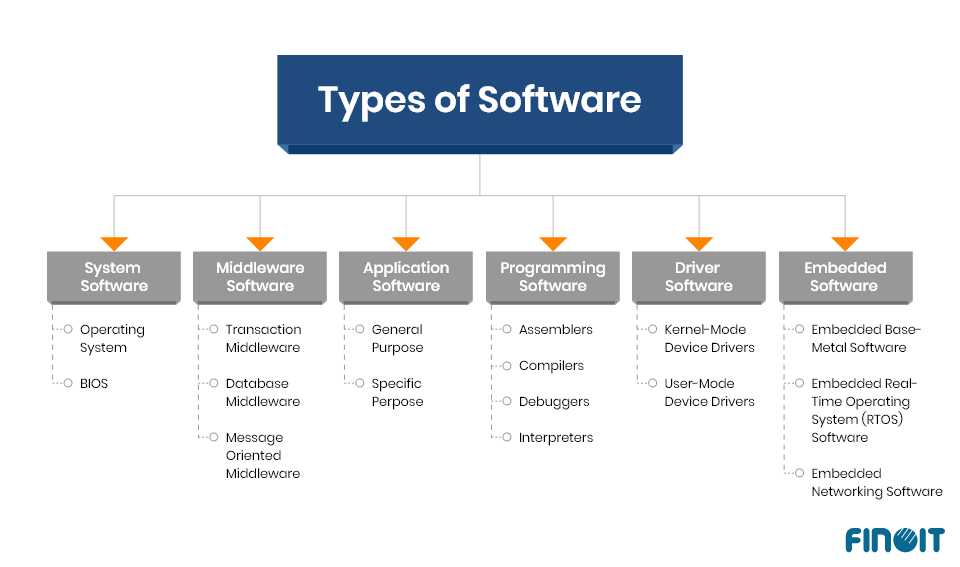So you’re curious about the most important type of software, huh? Well, in this article, we’ll be exploring the various types of software that exist and examining why one of them stands out above the rest. From productivity software that keeps us organized to security software that protects our digital lives, each type plays a significant role in our daily lives. But when it comes down to it, there’s one type that can truly be considered the backbone of our technological world. Let’s find out which one it is and discover why it holds such immense importance.
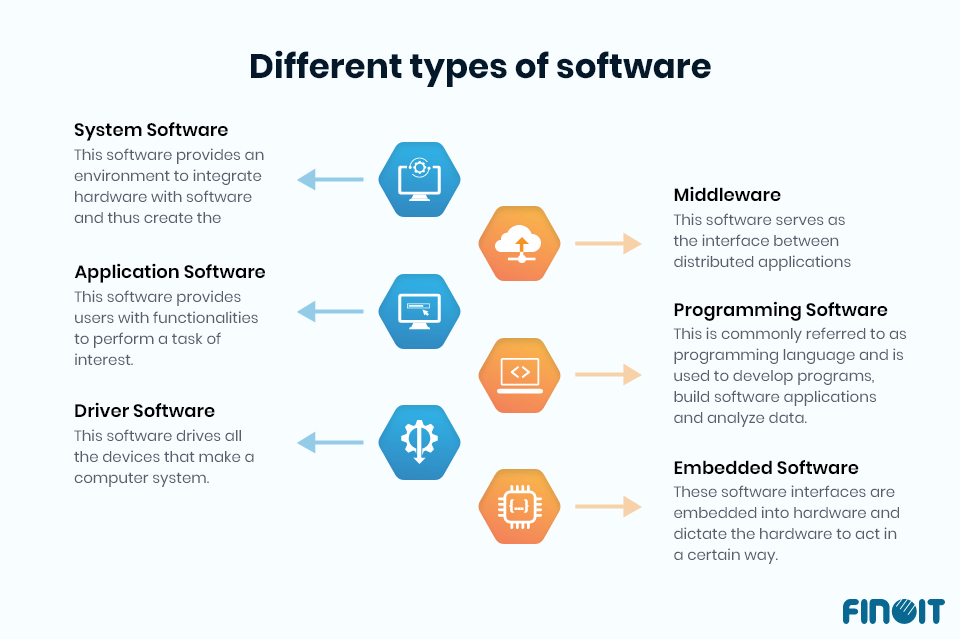
This image is property of www.finoit.com.
Operating Systems
Definition
An operating system (OS) is a software program that manages computer hardware and software resources and provides common services for computer programs. It acts as an intermediary between the user and the hardware of a computer, allowing users to interact with the computer system.
Importance in managing hardware resources
Operating systems play a crucial role in managing hardware resources efficiently. They allocate resources such as memory, processors, and input/output devices among various software applications, ensuring that they run smoothly without conflicts. By managing these resources effectively, operating systems maximize the performance and utilization of hardware, leading to optimal system efficiency.
Facilitating communication between software and hardware
Operating systems act as a bridge between software applications and hardware components. They provide an abstraction layer that enables software programs to communicate with the underlying hardware without having to know the intricate details of the hardware architecture. This abstraction layer simplifies the development process for software developers, as they can write applications that can run on different hardware configurations without needing to make significant changes.
Application Software
Definition
Application software refers to programs designed to perform specific tasks or functions for end-users. Unlike system software, which is primarily responsible for managing and operating computer systems, application software is intended to fulfill user requirements and cater to their specific needs.
Wide range of uses
Application software serves a wide range of purposes and can be found in various domains such as business, education, entertainment, and healthcare. From word processors and spreadsheet programs to graphic design tools and video editing software, application software encompasses a vast array of programs that enable users to accomplish specific tasks effectively.
Enables specific tasks and functions
The primary role of application software is to enable users to perform specific tasks or functions efficiently. It provides tools and features that facilitate the creation, manipulation, and presentation of content. For example, word processors allow users to create and edit documents, while accounting software helps in managing financial transactions. Without application software, users would have to resort to manual or time-consuming methods to accomplish these tasks, making them an essential part of our daily lives.
System Software
Definition
System software refers to a collection of programs and utilities that support the operation and management of computer systems. Unlike application software, which is designed for end-users, system software runs behind the scenes and provides essential services to the entire computer system.
Supports operation and management of computer systems
The primary purpose of system software is to ensure the smooth functioning and management of computer systems. It provides core services such as memory management, process scheduling, file system management, and device drivers. Without system software, the hardware components of a computer would not be able to communicate effectively with each other, leading to a breakdown in overall system performance.
Includes device drivers and utility programs
System software includes device drivers, which enable communication between the operating system and hardware devices. These drivers allow the operating system to recognize and utilize the functionalities offered by various hardware components. In addition, system software comprises utility programs that help in system maintenance, performance optimization, and troubleshooting. These utilities can perform tasks such as disk cleaning, software updates, and system backups, enhancing the overall user experience.
Security Software
Definition
Security software encompasses a range of programs designed to protect computer systems and data from unauthorized access, malware, and other security threats. It plays a critical role in ensuring the confidentiality, integrity, and availability of information in both personal and business environments.
Protects against unauthorized access and data breaches
One of the primary functions of security software is to protect computer systems and networks from unauthorized access. It does so by implementing various mechanisms such as authentication, access control, and encryption. Moreover, security software also guards against data breaches, which can have severe consequences, including identity theft and financial losses. It helps detect and prevent security breaches by monitoring network traffic, identifying malicious activities, and blocking potential threats.
Includes antivirus, firewalls, and encryption software
Some common types of security software include antivirus programs, which detect and eliminate viruses, malware, and other malicious software; firewalls, which monitor and control incoming and outgoing network traffic; and encryption software, which secures sensitive data by transforming it into an unreadable format. These security software tools work together to provide comprehensive protection against various security risks.
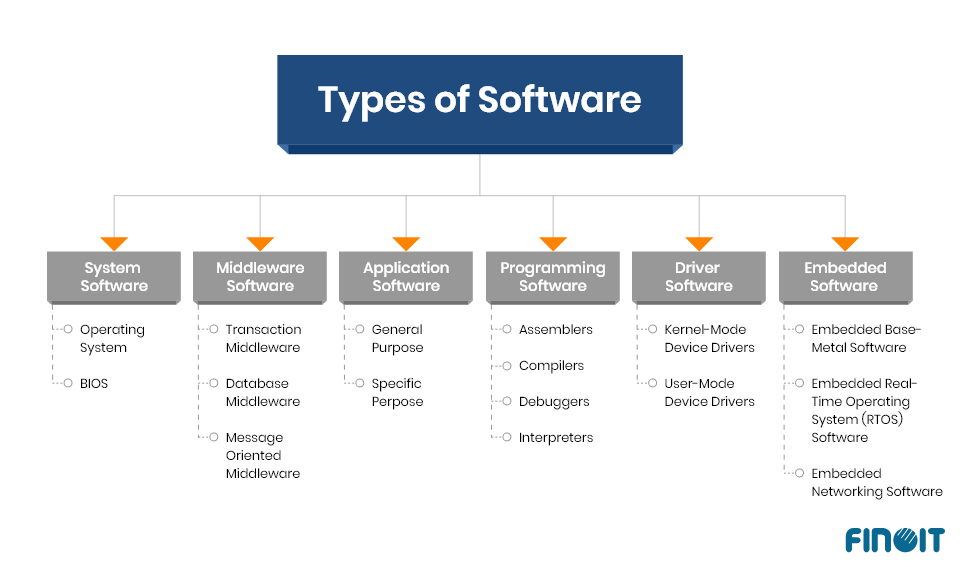
This image is property of www.finoit.com.
Programming Software
Definition
Programming software, also known as development software, encompasses a range of tools and environments that facilitate the creation, customization, and debugging of software applications. It provides developers with the necessary resources to write efficient and reliable code.
Enables development and customization of software applications
The primary role of programming software is to enable developers to write, test, and debug software applications. It provides features such as code editors, compilers, and debuggers that help in creating high-quality software programs. Additionally, programming software also includes Integrated Development Environments (IDEs), which offer a complete suite of tools and utilities for streamlined software development.
Includes compilers, IDEs, and debuggers
Compilers are a crucial component of programming software as they convert high-level programming code into machine code that can be executed by the computer. IDEs, on the other hand, provide developers with an integrated set of tools, including code editors, compilers, and debuggers, all in one cohesive environment. Debuggers are essential for identifying and fixing errors or bugs in the code, ensuring that software applications are robust and functional.
Database Software
Definition
Database software refers to applications that manage and organize large volumes of structured data efficiently. It provides mechanisms for storing, retrieving, and manipulating data, enabling organizations to handle vast amounts of information effectively.
Manages and organizes large volumes of data
The primary function of database software is to efficiently manage large volumes of structured data. It provides a structured framework for organizing data into tables, rows, and columns, facilitating easy storage and retrieval of information. Database software ensures data integrity, consistency, and security, allowing users to access and manipulate data seamlessly.
Provides efficient storage and retrieval mechanisms
Database software offers various mechanisms for efficient storage and retrieval of data. It uses query languages, such as SQL (Structured Query Language), to extract specific information from databases based on user-defined criteria. Additionally, it supports indexing, which enhances the speed of data retrieval operations by creating optimized data structures. Database software is vital in numerous domains, including finance, healthcare, and e-commerce, where vast amounts of data need to be stored, processed, and analyzed.

This image is property of www.finoit.com.
Graphics and Multimedia Software
Definition
Graphics and multimedia software encompasses a range of applications that enable the creation, editing, and presentation of visual and audio content. It plays a crucial role in various creative and professional fields where visual communication and media production are essential.
Enables creation, editing, and presentation of visual and audio content
Graphics and multimedia software provide tools and features that facilitate the creation and editing of visual and audio content. Image editors, such as Adobe Photoshop, allow users to manipulate and enhance images, while video editing software, like Adobe Premiere Pro, enables the editing and post-production of videos. Additionally, multimedia software also includes media players, which allow users to view and listen to audio and video content.
Includes image editors, video editors, and media players
Image editors offer a range of features, including filters, layers, and effects, enabling users to transform and enhance images according to their creative vision. Video editors, on the other hand, provide tools for cutting, merging, and applying effects to videos, giving users the ability to create professional-looking videos. Media players, such as VLC Media Player, support the playback of various multimedia formats, allowing users to enjoy audio and video content conveniently.
Internet and Web-based Software
Definition
Internet and web-based software refer to applications that facilitate online communication, collaboration, and information access. These software programs play a significant role in today’s interconnected world, enabling individuals and organizations to connect, interact, and share information globally.
Supports online communication and collaboration
Internet and web-based software provide essential tools and services that enable online communication and collaboration. Web browsers, such as Google Chrome and Mozilla Firefox, allow users to access websites, search for information, and interact with web-based applications. Email clients, such as Microsoft Outlook and Gmail, facilitate email communication and management. Content management systems, such as WordPress and Drupal, enable individuals and businesses to create and manage websites and online content effectively.
Includes web browsers, email clients, and content management systems
Web browsers are fundamental tools that allow users to navigate and access websites on the internet. They interpret HTML, CSS, and JavaScript, rendering web pages and executing web-based applications. Email clients, on the other hand, provide interfaces for sending, receiving, and managing email messages, along with additional features like calendar integration and contact management. Content management systems, commonly used by individuals and organizations, provide a user-friendly interface for creating, editing, and publishing web content without requiring in-depth technical knowledge.
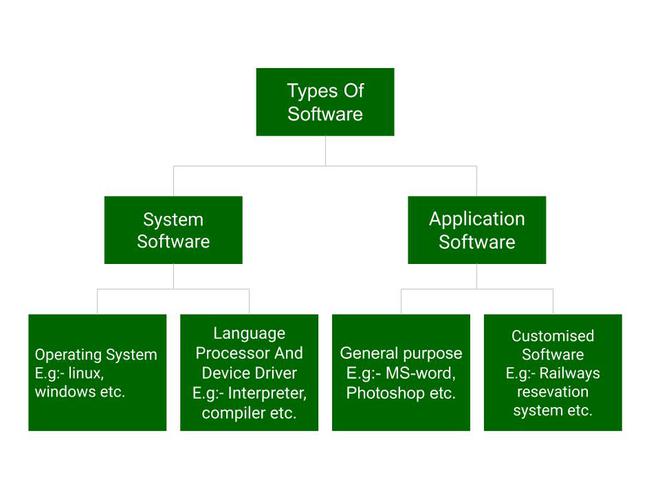
This image is property of media.geeksforgeeks.org.
Utility Software
Definition
Utility software comprises programs that perform specific tasks to enhance system performance and user experience. These tools aim to optimize system resources, streamline operations, and assist users in managing their computer systems effectively.
Performs specific tasks to enhance system performance and user experience
Utility software focuses on performing specific tasks to improve system performance and enhance the overall user experience. For instance, disk cleaners remove unnecessary files and free up disk space, boosting system efficiency. Backup tools enable users to create copies of their important files and data to avoid loss in the event of hardware failures or data breaches. System optimizers automate various maintenance tasks, such as software updates and disk defragmentation, resulting in improved system speed and stability.
Includes disk cleaners, backup tools, and system optimizers
Disk cleaners scan for temporary files, cached data, and other unnecessary files that accumulate on a computer system over time. They safely remove these files, reducing clutter and freeing up disk space. Backup tools allow users to create backups of their important files, ensuring that they can be restored in case of data loss. System optimizers offer a range of utilities, including software updaters, registry cleaners, and disk defragmenters, which streamline system operations and enhance performance.
Educational Software
Definition
Educational software includes programs and applications designed to aid in the teaching and learning processes. These tools incorporate multimedia elements, interactive features, and learning management systems to enhance educational experiences and provide targeted instruction.
Aids in teaching and learning processes
Educational software aims to support educators and learners by providing tools and resources that aid in teaching and learning processes. Interactive tutorials, for example, offer step-by-step instructions and practice exercises to help students grasp complex concepts effectively. Language learning apps leverage technology to provide interactive language courses, enabling learners to develop language skills at their own pace. Educational games make learning engaging and enjoyable by integrating educational content into interactive and entertaining gameplay.
Includes interactive tutorials, language learning apps, and educational games
Interactive tutorials provide learners with interactive materials, simulations, and assessments to foster active learning and understanding. These tutorials can cover various subjects, from mathematics and science to programming and music. Language learning apps leverage gamification techniques and interactive exercises to enhance language acquisition. These apps often provide features such as speech recognition and vocabulary building exercises. Educational games combine entertainment and education, encouraging learners to acquire knowledge and skills through interactive gameplay. These games cover a wide range of subjects, from history and geography to math and problem-solving.
In conclusion, it is difficult to pinpoint a single type of software as the most important, as each category plays a crucial role in different aspects of computing. Operating systems are essential for managing hardware resources and enabling communication between software and hardware. Application software caters to users’ specific needs and enables them to perform various tasks efficiently. System software supports the operation and management of computer systems. Security software protects against security threats and unauthorized access. Programming software facilitates the development and customization of software applications. Database software manages large volumes of data efficiently. Graphics and multimedia software enable the creation and presentation of visual and audio content. Internet and web-based software support online communication and collaboration. Utility software enhances system performance and user experience. Lastly, educational software aids in the teaching and learning processes, providing tools and resources for targeted instruction. Together, these types of software form the foundation of modern computing.
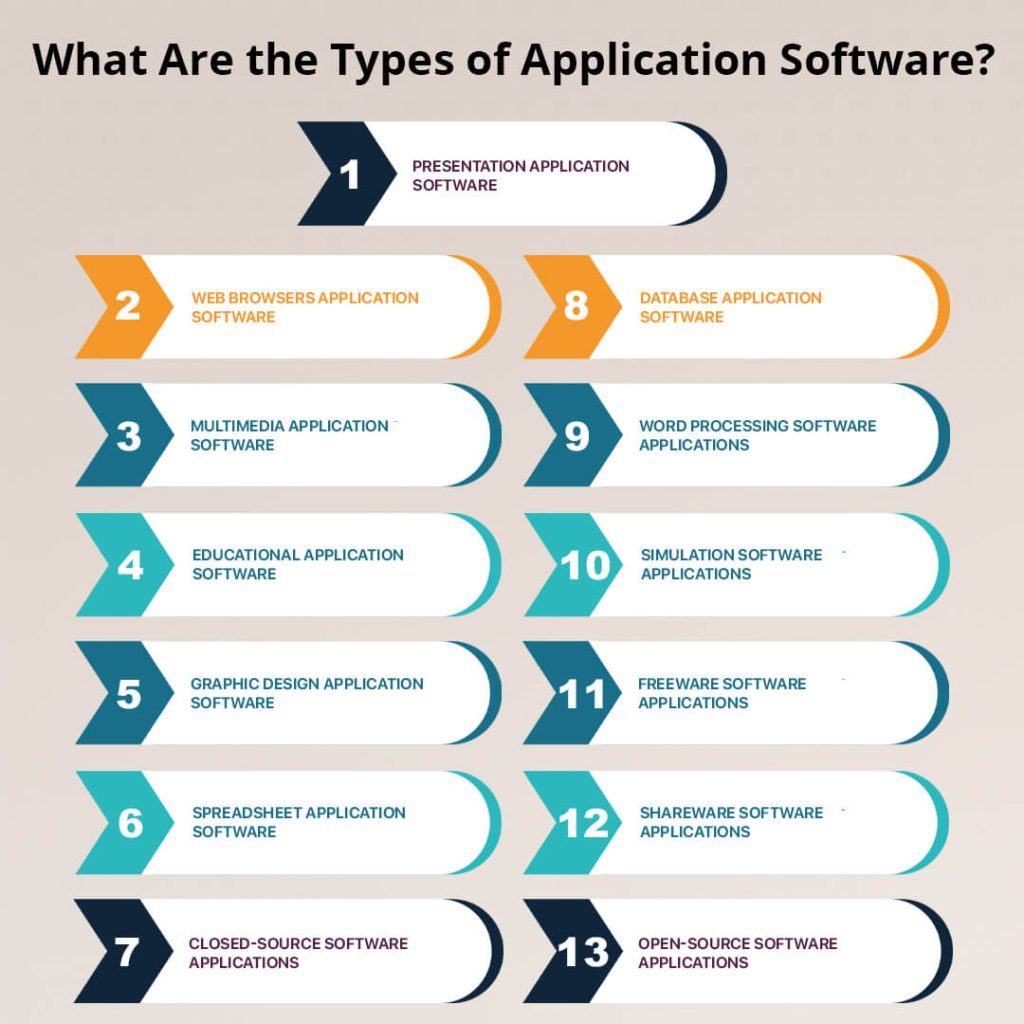
This image is property of www.hyperlinkinfosystem.com.
